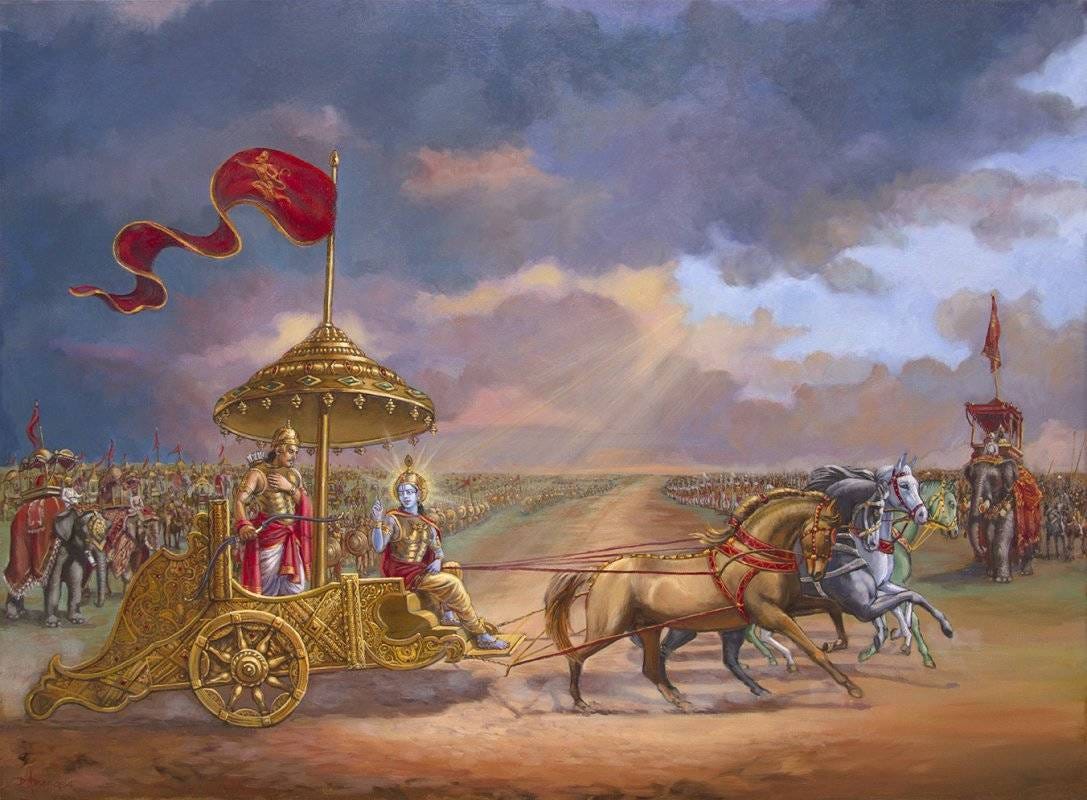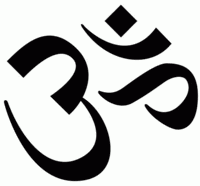Discussion on Bhagwad Gita: Chapter 1; Verse 2 through 6

दृष्ट्वा तु पाण्डवानीकं व्यूढं दुर्योधनस्तदा।
आचार्यमुपसंगम्य राजा वचनमब्रवीत्॥१-२॥
Hindi
हे राजन, पाण्डवों की सेना व्यवस्था देख कर दुर्योधन ने अपने आचार्य के पास जा कर उनसे कहा।
Brajbhasha / ब्रजभाषा
दिव्य नयन माहीं संजय ,
जस देख रहे, तस् बोल रहे,
दुरजोधन पाण्डुन व्यूह मयी,
सेना लखि द्रोण सों बोल रहे
English
Looking at the Armies, Duryodhan went over to his teacher and said..
******* ******** ********
पश्यैतां पाण्डुपुत्राणामाचार्य महतीं चमूम्।
व्यूढां द्रुपदपुत्रेण तव शिष्येण धीमता॥१-३॥
Hindi
हे आचार्य, आप के तेजस्वी शिष्य द्रुपदपुत्र द्वारा व्यवस्थित की इस विशाल पाण्डू सेना को देखिये।
Brajbhasha / ब्रजभाषा
हे गुरुवर ! व्यूहमयी ठाड़ी,
पाण्डु के पुत्रन की सेना.
द्रुपद सुतन ने जाहि रच्यो,
जुद्ध इनहीं सों तो होना
English
Sir, please see the large army which has been specially lined up by your illustrious student, Dhrishtadyumna.
******* ******** ********
अत्र शूरा महेष्वासा भीमार्जुनसमा युधि।
युयुधानो विराटश्च द्रुपदश्च महारथः॥१-४॥
धृष्टकेतुश्चेकितानः काशिराजश्च वीर्यवान्।
पुरुजित्कुन्तिभोजश्च शैब्यश्च नरपुङ्गवः॥१-५॥
युधामन्युश्च विक्रान्त उत्तमौजाश्च वीर्यवान्।
सौभद्रो द्रौपदेयाश्च सर्व एव महारथाः॥१-६॥
Hindi
इसमें भीम और अर्जुन के ही समान बहुत से महान शूरवीर योधा हैं जैसे युयुधान, विराट और महारथी द्रुपद, धृष्टकेतु, चेकितान, बलवान काशिराज, पुरुजित, कुन्तिभोज तथा नरश्रेष्ट शैब्य। विक्रान्त युधामन्यु, वीर्यवान उत्तमौजा, सुभद्रापुत्र (अभिमन्यु), और द्रोपदी के पुत्र – सभी महारथी हैं।
Brajbhasha / ब्रजभाषा
यही सेना माहीं धनुर्धारी,
अर्जुन और भीम सों वीर महे,
जस सात्याकि और विराट महारथ
राजा द्रुपद सों वीर अहे ॥१-४॥
चेकितान वीर और धृष्टकेतु ,
पुरजित बलि काशी राजहूँ को.
नर मांहीं विशेषहूँ शैव्य अहे ,
कुंती भोज सों वीरहूँ को ॥१-५॥
बलवीर बलिष्ठ युधामन्यु,
द्रौपद के पाँचहुँ पुत्र महे.
अभिमन्यु पुत्र सुभद्रा को,
उत्तमौजा सों वीरहूँ तत्र रहे ॥१-६॥
English
In this Army, there are many brave warriors of Bheem and Arjun’s caliber, such as Yuyudhaan, Virat, the Great Warrior Drupad, Dhrishtketu, Chekitan, brave Kashiraj, Purujit, Kuntibhoj and great among human beings, Shaibya. Great Yudhamanyu, brave Uttamaujas, Subhadra’s son Abhimanyu, and the sons of Draupadi – All the brave warriors are there.
******* ******** ********
Discussion
What we have here is an interesting set of characters and a strange situation on our hands!
Let’s get our introductions to the cast of characters that Duryodhan talks about.
Dhrishtadyumna (means daring or great) was the son of King Draupada (King of Panchal) and brother of Draupadi (wife of the Pandavas) and Shikhandi. Shikhandi was born a woman (Shikhandini) but was raised as a man and had her sex “exchanged” with a Yaksha to become a man until he died, after her wife rejected her on knowing her truth. After the sex change, Shikhandini went back as Shikhandi and lived a man’s life until his death. Shikhandi / Shikhandini had taken this birth to avenge the insult by Bhishma and vowed to kill him, after in a previous birth she (as Amba) was humiliated by Bhishma when Amba proposed him. Bhishma had decided never to marry.
Yuyudhaan, also known as Satyaki, was from Shri Krishna’s Yadava-Vrishni clan. He had trained under Drona along with Arjun and other Pandavas and had stunned Drona once by breaking his bow 101 times. It was Yuyudhaan who had accompanied Shri Krishna to Hastinapur on the last Peace Mission. Interestingly, Satyaki and Kritavarma were two Yadava fighters, who ended up fighting on the opposite sides. Kritavarma joined the Kauravas, while Satyaki joined the Pandavas. During Mahabharat, Bhurisravas and Satyaki fought a terrible battle where the former was about to kill a defenseless Satyaki when Arjun shot Bhurisravas and cut his arm off. Satyaki, then gets up and kills Bhurisravas, for which he is condemned. Kritavarma, on the other hand, ended up killing the sons of Panchali (Draupadi) and the Pandavas in a disgraceful night attack. Many years after the war, as Krishna’s time on earth was coming to an end, Kritavarma and Satyaki both get involved in a drunken brawl and get killed along with their other warriors. Thus with the death of Shri Krishna, the Yadava clan comes to an end.
Virat was from the Fishermen’s Dynasty called Matsya dynasty. A Chedi king, Uparichara – a Paurava king (of Puru dynasty) had 5 sons of queens and one son and a daughter from women in Fishermen’s community.. The male child, Virat, grows up to become the ruler and establishes the Matsya dynasty. The fisherman daughter moves to banks of Yamuna from Saraswati (as it was drying up) in the Kuru Kingdom. Kuru king Santanu’s wife Satyavati was from this fishermen’s community. Kuru kings Chitrangada and Vichitravirya were sons of Satyavati – the Queen from the fishermen community. In turn Pandavas and Kauravas were grandsons of Vichitravirya. King Virat of the Matsya dynasty had its capital in Viratnagar, which is current day Bairat in Jaipur district of Rajasthan. Meenas, who are today the Scheduled Castes are the descendants of Virat. King Virat was also the father in law of Abhimanyu – son of Arjun. When the Pandavas were exiled for 13 years, they spent most of that time in the kingdom of King Virat.
Chekitana was son of Dhrishtaketu, Raja of the Kekayas, who again was the ally of Pandavas. Chekitan is a gotra of the Jats of today from Gujranwala.
Purujit was the Kunti’s father.
Yudhamanyu was from Draupadi’s Panchal royal family. His main task was to save Arjun from all the flanks and was assisted by Uttamaujas. He was unharmed during the war but was finally killed in the night attack by Kritavarma and Ashwathama.
A few things stand out from these verses:
In most conflicts – of mind and of body – it is not easy to distinguish between ‘Us” and “Them”. If your mind is looking for such meaningless distinctions, then it will more often end up in a mess. For, whatever we call “Them” – has a part of “Us” and vice versa. There is no clean cut distinction. There cannot be any. In this war, the two sides had friends fighting from opposing camps; a Guru (Drona) and his most obedient student (Arjun) on the opposite sides.
It was in this backdrop – where the incumbent war was obviously terrible in its portents and yet the loyalties and relationships were criss-crossed – that Shri Krishna gave the message of Karma.
Aren’t we all having a personal Mahabharat, with mixed commitments and competing loyalties and relationships fighting each other? Such a war that is paralysing us completely in a way that we cannot decide what is “right” and what is “wrong”? Our stakes and results from actions are not as high as they were for Arjun and other warriors in Mahabharat. We will survive, but most of them wouldn’t have by the end of it. When the highest message of Karma was given in such a stage of unprecedented danger and doom, it was given such that it will drive home the gravity of it.
Despite the coming man slaughter, the seemingly ruthless message of “Go fight” was given to underscore the great primacy of Action as opposed to Inaction. And, that Action is neither “right” nor “wrong”.
The being who promised not to pick arms and fight in the war, goes on to tell Arjun to fight as that is the Dharmic action!
One who tried his level best until the end to avoid the war despite humiliation, gave the message of action – even if it meant war and violence. Nothing can be more ironical than this. If Violence was “right’ for Arjun, then it was “right” for Shri Krishna as well. And if Shri Krishna has vowed not to pick arms, then how was Arjun’s picking arms “Dharmic”?
Masters and Enlightened beings do have the ability to move multitudes to liberation in a moment. Yet they don’t. They let the “Natural Cosmic law” of every being going on their own spiritual exploration “play out”. They are there as “Guides” when needed and at the level where required, but they will not “do the work” for you.
War was incumbent on its protagonists. Shri Krishna was there as a Guide. He gave enough chances and options to Kauravas to succeed. The choice between him and his army was given first to Duryodhana and he went for Krishna’s big army and let him go to the side of the Pandavas. Throughout the war, he guided warriors as to the actions and the strategies, but never himself took part, although he had probably the most dangerous seat in the war as Charioteer of Arjun, who was arguably the most marked man in the entire two Armies. Defenseless, in the line of fire of the most marked man and yet vowing not to fight the war with arms – its a rare lesson in spirituality that we all miss! Being in the thick of life, without the defense of ego and our machinations is the way to live without getting affected.
He was involved fully, and yet not part of it! That is how Krishna ultimately teaches one to be – be fully involved wanting to get the most out of every moment (if you are playing, then play to win), but don’t be a part of the game such that the game starts dictating your actions. Its all a game after all. You should play to win, but winning is not your choice. If you are “part of the game” and let the game take over your own being, then you will not know how to lose. Nor how to be a winner.
Finally, one point that is not noticed by many while reading Gita or Mahabharat is that there were at least 4 generation of warriors fighting in the same battlefield. Bhishma was there – who was the Grandfather. Vidur was there – who was a half brother to Dhritarashtra and Pandu.
The generation of Pandavas and Kauravas was there. And then their kids – like Abhimanyu and the 5 sons of Pandavas and Panchali. And no one was fighting on the sidelines. Everyone, including Bheeshma was a tough warrior to fight against. As was Abhimanyu.
It means that the body and mental fitness levels of people in that generation was nothing short of remarkable! The fighters and warriors are spoken of, from across generations as if it is a matter of fact. There is no amazement or miracle that Bheeshma or Vidur could be in a battle for the writer of the text. It is spoken, as if it were a natural thing to happen.
At the very least, Mahabharat is a lesson to the current generation of Indians who start announcing their life is over as soon as they cross 40 and start behaving and acting as old men and women. There is no grace in fragile and senile Old age. Grace is in keeping the body and mind at its highest ability while you are working through them.
The generation of Mahabharat was a fairly active and “young” (mentally and physically) even at remarkably old ages.
If one could just take this one message out of Gita and Mahabharat, even that could change the landscape and destiny of India and Indians – and the world – forever!




